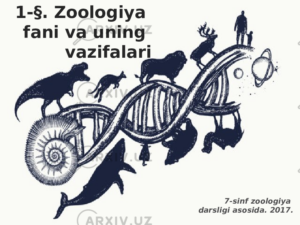SHARE WITH FRIENDS:
Topic: Zoology and its tasks
Plan:
-
Zoology is a science that studies animals.
-
Zoology is the oldest science
-
Animal diversity and habitat.
-
Importance of animals.
-
Protection of animals.
Zoology is a science that studies animals. Zoology (zoon- hay von, logos- science) is a science that studies the structure, life, reproduction and development of animals. The task of zoology is to study the diversity and distribution of animals, their importance in nature and in human life, and their origin. Zoology consists of several disciplines. One group of them studied the structure, reproduction, development, distribution of animals on the earth, others studied their individual groups.
Zoology is the oldest scienceThe oldest works on zoology were written by the great Greek scientist Aristotle 4 centuries before our era. About 500 species of animals are described in his works. Dutch scientist Anton Leeuwenhoek, who lived in the 16th and 17th centuries, discovered animals that can be seen under a microscope. In the 18th century, the Swedish scientist Carl Linnaeus proposed to study animals by dividing them into species, genera, families and classes. English scientist Ch. Darwin developed his universal theory of evolution by studying animals in the mid-19th century. Zoology is related to medicine, animal husbandry and other fields of national economy. Uzbek scientists have contributed a lot to the development of zoology. DN Kashkarov was one of the first to start studying animal ecology. The research conducted by LM Isayev and PF Borovsky became the basis for the elimination of dangerous parasitic animals such as rabies, malaria parasite and leishmania in Central Asia. TZ Zohidov, OP Bogdanov and other scientists
Animal diversity and habitat. There are about 2 million species of animals on earth. Land, air, soil, water bodies are the main habitat for animals. For parasitic animals, human, animal and plant organisms are habitats. The characteristics of the formation and life of animals are adapted to a certain environment. For example, the bodies of aquatic animals are slender, and their legs are turned into paddles. Animals living on land have flat bodies and well-developed legs. Humidity, temperature, light, etc., which make up the components of the living environment, are called environmental factors. The body size of animals is different (Fig. 1). They range from giant whales weighing up to 150 tons to species that can only be seen under a microscope and are only a tenth or even a hundredth of a millimeter long. Importance of animals.Animals are of great importance in nature and in human activities. Most animals eat green plants. They are called herbivores. Animals that eat other animals are carnivores; animals that live in human, other animal and plant tissues are considered parasites. Herbivorous animals grind plants and their remains and accelerate their decay. Due to their activity, mineral substances necessary for the plant are collected; soil fertility increases. Animals include animal carcasses, organic remains and micro-
There are many species that feed by filtering organisms from water. Such animals are called natural sanitation. They protect the surface of the earth and water bodies from pollution. Domestic animals not only provide meat and milk, but also fur, fur and other products for industry. Bees and butterflies pollinate plants and help increase their productivity. Insectivores and carnivores, birds, bats, and frogs benefit by destroying forest and agricultural pests. Among the animals, there are many species that harm people, livestock and plants. Blood-sucking insects and ticks, along with parasitism, spread diseases such as plague, sweating, and malaria. Our famous compatriot Abu Ali ibn Sina wrote about avoiding animals that cause diseases in his "Laws of Medicine".
Protection of animals. Humans have hunted wild animals since ancient times; used their meat, skin and other products; animals were trained; they were used as house guards and labor force. Then, under the influence of the increase in the population, the improvement of hunting weapons, and the destruction of the natural conditions necessary for animals, the European species (cattle breed), tarpan (horse breed), Steller's cow (sea animal) disappeared. slipped away; Animals such as Przewalski's horse, bison, bison, gazelle, and khangul were threatened with extinction. This situation requires the protection of animals and their environment. Badaytokai, Kyzylkum, Zarafshan, Surkhan and Hisar state reserves, Chotkal biosphere reserve, several national parks and private reserves have been established in order to preserve and breed rare and declining animals in the territory of our republic. . The latest 2016 edition of the "Red Book" of the Republic of Uzbekistan includes 205 species of rare and endangered animals.
Control questions
-
What are the services of K. Linnaeus in the development of zoology?
-
What is the environment and its factors?
-
What are the groups of animals according to their diet?
